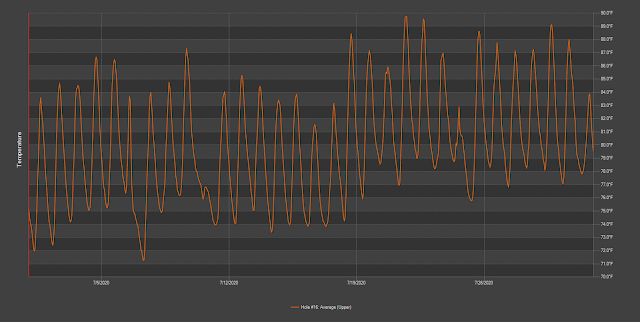When talking with someone about how hot it is outside, most of us focus more on the daytime high temperatures, and aren't quite as concerned about the nights, when we can crawl into bed with our A/C keeping us cool. Plants aren't so fortunate.
Last week we discussed how hot July was--during the day--but a case could be made that the nighttime temperatures hurt the turf just as much as the daytime temperatures did. A good example of this can be seen on July 24 and 25, where the daytime highs for the two days net to average with historical numbers. However, the low temperatures on both nights were five degrees above average (71 versus 66).
In looking at the numbers for the entire month of July, we see that 87% of the daily low temperatures were at or above the average. As a whole, the month was 4.3 degrees hotter at night than "normal." The plants just aren't catching a break during these periods, when soils are hot around the clock.
The graph below is from one of our soil sensors buried in #16 fairway, and shows the daily peaks and valleys of the soil heating and (sort of) cooling. Throughout the entirety of July, there wasn't a moment when the root zone was below 70 degrees.
Some folks may be saying to themselves, "During both the day and night in July, you're only talking about four degrees above average--what's the big deal?"
Well, think of it this way: If your ideal temperature is, for example, 72 degrees inside your home, and you're told that you will have to deal with it being 92 degrees for a month or more, you definitely wouldn't be a happy camper. Now, what if we say it's going to be 96 degrees for that month in your house--that four degree difference might not seem so tiny any more.
The point is, the hotter day and night temperatures aren't taking place during ideal growing conditions, but during what are already very stressful times for cool-season turf. An extra four degrees both day and night for more than a month, can easily be enough for plants to "raise the white flag."
As we get into August, the low temperatures are continuing the trend of being warmer than average. Of course, eventually (perhaps in October) it will cool off enough that we will see new root growth. However, there is no doubt that we will be adding this summer's weather to the many things we would have passed on during the crazy year of 2020.


















































